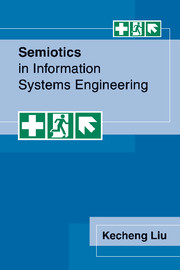Appendix A - Semantic templates and surrogate specification
Published online by Cambridge University Press: 19 September 2009
Summary
This appendix, as a supplement to section 10.2, supplies further details of Semantic Templates (ST) and the use of ST for database design.
Definition of ST
The definition of ST, basically following a syntax of Backus–Naur form, describes the structure of a semantic template.
ST:=‘<’ agent,ST,mood+,mood–,time+, time– ‘>’| ST:= ‘<’ agent, action, time+,time–‘>’;
agent:= agent performing the action;
action:= realisation of affordance;
mood+:= mood;
mood–:= mood;
mood:= proposal | inducement | forecast | wish | palinode | contrition | assertion | valuation;
proposal:= ‘request’|‘ask’|‘beg’|‘command’|‘insist’|‘suggest’|‘promise’|‘guarantee’;
inducement:= ‘reward’|‘threaten’|‘warn’|‘tempt’;
forecast:= ‘predict’|‘assume’|‘plan’|‘accept’;
wish:= ‘want’|‘hope’|‘expect’|‘desire’;
palinode:= ‘retract’|‘annul’|‘revoke’|‘deny’;
contrition:= ‘regret’|‘apologise’;
assertion:= ‘assert’|‘claim’|‘report’|‘notify’|‘affirm’|‘assure’|‘argue’|‘declare’;
valuation:= ‘judge’|‘appraise’|‘blame’|‘criticise’|‘accuse’|‘object’;
time+:= time;
time–:= time;
time:= absolute time or relative time (by reference to another action).
The right-hand phrases in italics are explanations of the possible value types of the left-hand items. For example, the ‘agent’ is defined as ‘agent performing the action’, which refers to the agent appearing on the ontology chart and relating to the action as the antecedent. The ‘action’ is defined as ‘realisation of affordance’; the affordance should also be predefined on the ontology chart so that there can be a realised instance of the affordance. This can be illustrated by relating to the example shown in Figure 9.4, and it will be used throughout this appendix. In that figure, a person, John, is the agent; a particular case of John's being absent is a realisation of the affordance ‘absence’.
Information
- Type
- Chapter
- Information
- Semiotics in Information Systems Engineering , pp. 196 - 200Publisher: Cambridge University PressPrint publication year: 2000
